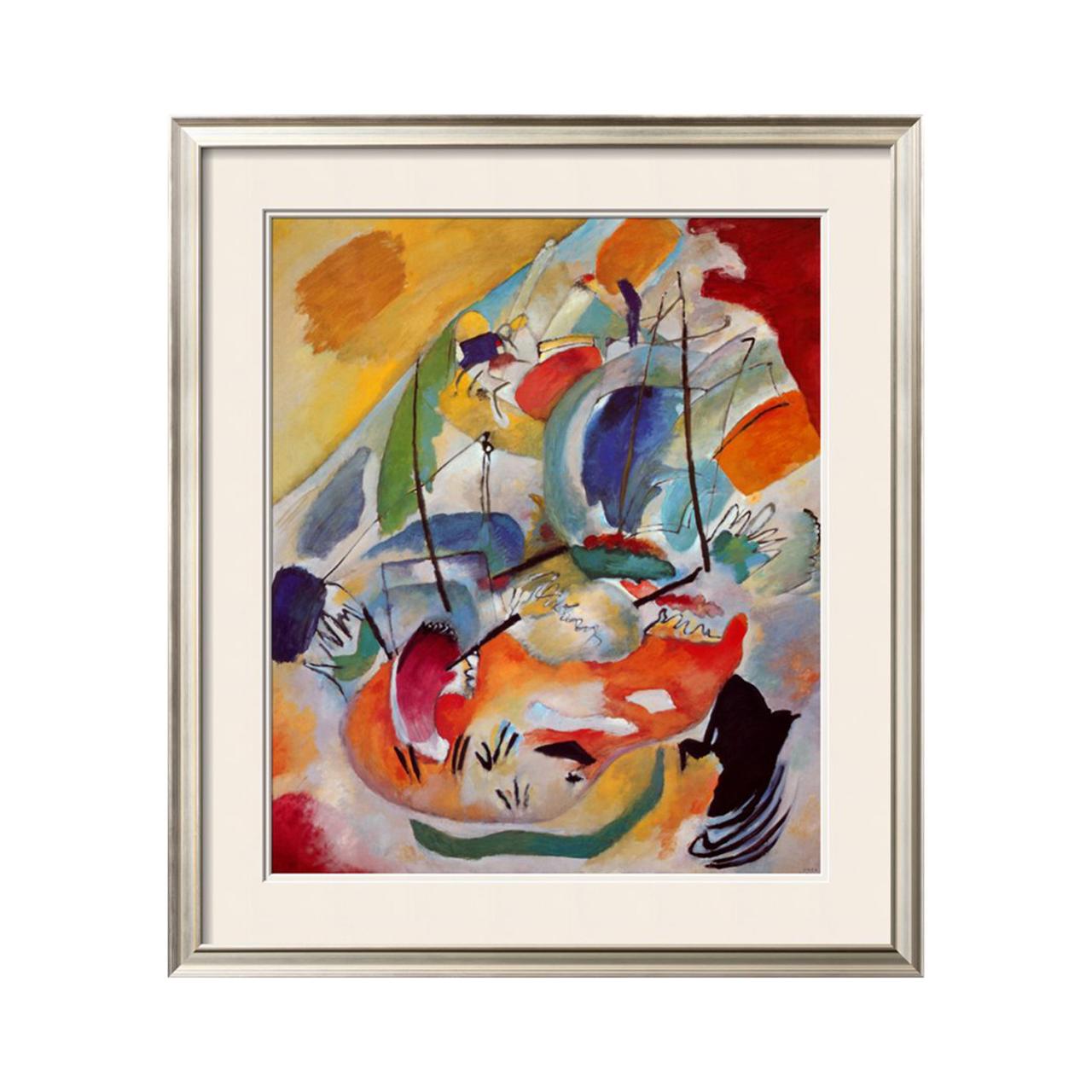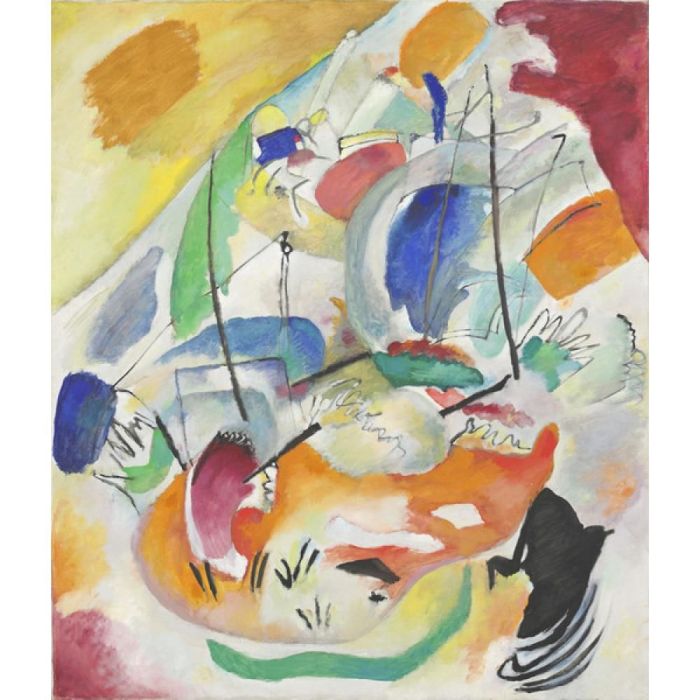Kandinsky improvisation 31 sea battle – Wassily Kandinsky’s Improvisation 31: Sea Battle, created in 1913, stands as a seminal work in the development of abstract art. This captivating painting exemplifies Kandinsky’s unique style, blending vibrant colors, dynamic lines, and symbolic imagery to evoke a profound emotional response.
Kandinsky’s artistic journey, influenced by Fauvism and Cubism, culminated in the creation of Improvisation 31: Sea Battle. The painting’s composition, characterized by its rhythmic interplay of geometric shapes and organic forms, reflects his exploration of the relationship between music and visual art.
Kandinsky’s Artistic Style
Kandinsky’s artistic style was unique in its use of abstraction and symbolism. He believed that art should not be representational, but should instead express the inner emotions of the artist. Kandinsky’s paintings are often characterized by their vibrant colors, geometric shapes, and dynamic compositions.Over
time, Kandinsky’s style evolved from a more representational style to a more abstract style. In his early work, he used more traditional techniques, such as perspective and shading. However, as he progressed, he began to experiment with more abstract forms and colors.
In his later work, he often used pure colors and geometric shapes to create a sense of movement and energy.Kandinsky was influenced by a number of other artists, including the Fauves, the Cubists, and the Expressionists. However, he ultimately developed his own unique style that was unlike any other.
Influence of Other Artists
Kandinsky was influenced by a number of other artists, including the Fauves, the Cubists, and the Expressionists. The Fauves were a group of French artists who used bright, vibrant colors to create a sense of emotion and energy. The Cubists were a group of French artists who used geometric shapes to create a sense of space and depth.
The Expressionists were a group of German artists who used exaggerated colors and forms to express their inner emotions.Kandinsky was particularly influenced by the work of the Fauves. He admired their use of bright colors and their ability to create a sense of emotion and energy.
He also admired the work of the Cubists, but he was not as interested in their use of geometric shapes. Instead, he preferred to use geometric shapes to create a sense of movement and energy.Kandinsky’s style was also influenced by the work of the Expressionists.
He admired their use of exaggerated colors and forms to express their inner emotions. However, he did not want his art to be as emotional as the Expressionists. Instead, he wanted his art to be more intellectual and abstract.
Improvisation 31: Sea Battle
Kandinsky’s Improvisation 31: Sea Battle, painted in 1913, exemplifies his pioneering approach to abstract art. The painting’s dynamic composition and vibrant colors evoke a sense of chaos and movement.
Composition and Elements, Kandinsky improvisation 31 sea battle
Improvisation 31: Sea Battleis characterized by a non-representational composition. The canvas is filled with a complex arrangement of geometric shapes, lines, and colors. These elements interact and overlap, creating a sense of visual tension and dynamism.
The painting’s focal point is a large, angular shape in the center. This shape is surrounded by a series of smaller shapes and lines, which appear to be moving and colliding. The use of contrasting colors, such as red, blue, and yellow, further enhances the sense of movement and energy.
Color, Line, and Form
Kandinsky’s use of color, line, and form in Improvisation 31: Sea Battleis deliberate and expressive. The bright, saturated colors create a sense of vibrancy and energy. The lines are dynamic and energetic, contributing to the painting’s overall sense of movement.
The geometric shapes in the painting are used to create a sense of order and structure. These shapes are often overlapped and intersected, creating a sense of visual complexity and depth.
Symbolism and Meaning
The title of the painting, Sea Battle, suggests that it may have been inspired by the chaos and violence of war. The painting’s dynamic composition and use of contrasting colors evoke a sense of conflict and struggle.
However, Kandinsky’s abstract style allows for multiple interpretations. The painting can also be seen as a representation of the inner turmoil and emotional struggles of the artist.
Context and Historical Significance

Kandinsky’s Improvisation 31: Sea Battle was created in 1913, during a period of great social and political upheaval in Europe. The painting reflects the artist’s response to the escalating tensions leading up to World War I.
Influence of Contemporary Events
The painting’s title, “Sea Battle,” alludes to the naval battles that were a common occurrence during the Balkan Wars of 1912-1913. Kandinsky was deeply affected by the news of these conflicts, which he saw as a harbinger of a larger war to come.
The painting’s abstract forms and vibrant colors convey the chaos and violence of war. The swirling lines and jagged shapes suggest the movement of ships and the explosions of artillery shells.
Reception and Impact
Improvisation 31: Sea Battle was met with mixed reactions when it was first exhibited in 1914. Some critics praised the painting’s originality and expressive power, while others were shocked by its abstract style.
Despite the controversy, the painting had a profound impact on the art world. It helped to establish Kandinsky as a pioneer of abstract art and paved the way for the development of new artistic movements in the 20th century.
Symbolism and Interpretation
Improvisation 31: Sea Battle is a complex and multilayered painting that invites various interpretations. Kandinsky employed a rich vocabulary of symbols and motifs to convey his emotions and ideas.
Symbols and Motifs
The painting features a dynamic composition of geometric shapes and organic forms. The sharp angles and bold lines evoke a sense of tension and conflict, while the curved shapes and soft colors suggest movement and fluidity. Kandinsky also incorporated several symbolic elements, including:
- Circles:Circles represent the sun, the moon, and the celestial realm.
- Triangles:Triangles symbolize conflict, tension, and dynamism.
- Squares:Squares represent stability, order, and the material world.
- Colors:Kandinsky used a vibrant palette, with warm colors (reds, oranges, yellows) representing energy and passion, and cool colors (blues, greens) representing calm and tranquility.
Overall Meaning and Message
The overall meaning of Improvisation 31: Sea Battle is open to interpretation. Some scholars believe it reflects Kandinsky’s inner turmoil and anxiety during World War I, while others see it as a celebration of the power of nature and the resilience of life amidst chaos.
Different Perspectives
Different perspectives and interpretations of the painting have emerged over time. Some critics have focused on its formal qualities, emphasizing its innovative use of color and composition. Others have explored its psychological and spiritual dimensions, seeing it as a reflection of Kandinsky’s own emotional experiences and his belief in the spiritual power of art.
Comparison with Other Kandinsky Works
Kandinsky’s Improvisation 31: Sea Battleexhibits distinct characteristics compared to his other works, while also showcasing elements that align with his artistic evolution.
Similarities
- Abstract Expressionism:Like many of Kandinsky’s works, Improvisation 31: Sea Battleembodies the principles of abstract expressionism, emphasizing the artist’s emotions and inner experiences through non-representational forms and colors.
- Dynamic Composition:Kandinsky often employed dynamic compositions that create a sense of movement and energy. Improvisation 31: Sea Battledemonstrates this through its swirling, intersecting lines and organic shapes.
Differences
- Color Palette: Improvisation 31: Sea Battlefeatures a predominantly blue and green color palette, evoking the theme of the sea, which contrasts with the vibrant, often primary colors found in many of his other works.
- Organic Forms:While Kandinsky often incorporated geometric shapes into his compositions, Improvisation 31: Sea Battleis characterized by more organic, fluid forms that suggest the fluidity and motion of the sea.
Artistic Trajectory
Improvisation 31: Sea Battlefalls within Kandinsky’s period of artistic development where he was exploring the expressive potential of abstract forms and colors. This work represents a departure from his earlier, more structured compositions and marks his transition towards a more fluid, intuitive style.
Influence on Modern Art

Kandinsky’s Improvisation 31: Sea Battle exerted a profound influence on the development of modern art. It challenged traditional notions of representation and paved the way for abstract expressionism.
The painting’s vibrant colors, dynamic forms, and lack of recognizable imagery resonated with artists seeking to break free from the constraints of representational art. Its spontaneity and emotional intensity inspired subsequent generations of artists to explore the expressive potential of abstract forms.
Contribution to Abstract Art
- Abstraction:Improvisation 31: Sea Battle marked a decisive shift towards abstraction, breaking away from traditional depiction of objects and scenes.
- Emotional Expression:Kandinsky believed that colors and forms could convey emotions directly, without the need for representational imagery.
- Improvisation:The painting’s spontaneous and improvisational nature emphasized the importance of intuition and subconscious expression.
Enduring Legacy
Improvisation 31: Sea Battle remains a seminal work in the history of modern art. Its influence can be seen in the works of numerous subsequent artists, including:
- Jackson Pollock:Pollock’s drip paintings were inspired by Kandinsky’s use of spontaneity and improvisation.
- Mark Rothko:Rothko’s color field paintings owe a debt to Kandinsky’s exploration of the emotional impact of color.
- Yves Tanguy:Tanguy’s surrealist landscapes were influenced by Kandinsky’s use of abstract forms to evoke psychological states.
Kandinsky’s Improvisation 31: Sea Battle stands as a testament to the power of abstraction and the transformative potential of modern art.
User Queries: Kandinsky Improvisation 31 Sea Battle
What is the significance of the title “Sea Battle”?
The title alludes to the painting’s dynamic composition, suggesting a sense of conflict and tension between the geometric and organic elements.
How does Kandinsky use color in Improvisation 31: Sea Battle?
Kandinsky employs vibrant and contrasting colors to create a sense of visual tension and evoke emotional responses.
What is the symbolic meaning behind the various shapes in the painting?
The geometric shapes represent structure and order, while the organic forms symbolize fluidity and movement, reflecting Kandinsky’s belief in the unity of opposites.